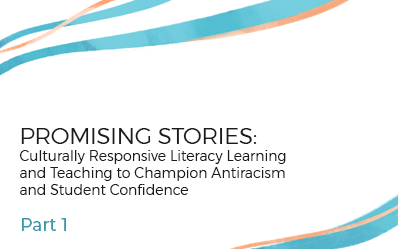Promising Stories, Part 1: Introduction
This is the first in a multi-part series by Laura Benson, ISS Director of Curriculum and Professional Development. Find other installments here: Part 2, Part 3, Part 4, Part 5, Part 6.
Promising Stories: Culturally Responsive Literacy Learning and Teaching to Champion Antiracism and Student Confidence
Children of color and white children who live in poverty, like all children, want to learn and read good stories. Given that America is founded on fairness and tolerance, can’t we as a nation write them more promising stories?
From “It Begins with Belief…” by Eric Cooper in Voices in the Middle
Introduction
Our students bring radiant stories to our learning tables. When they enter our classrooms, our students carry their cultures with them – their ethnic heritages, their life experiences, their racial identifications, their passions, their ages, their family histories – the all of themselves. And, if we tap into these rich wells, culture can be the cornerstone of promise for our students.
Culture is the lens by which one looks at the world and, thus, profoundly shapes relationships, motivation, engagement, and achievement. Stefanie Rome (2006) names culture as “whatever is meaningful and relevant to the learner.” Stefanie’s wise counsel means that we must know our students deeply to match the learning to the learner. Geneva Gay insightfully defines the compass of culture in Culturally Responsive Teaching:
The first premise is that culture is at the heart of all we do in the name of education, whether that is curriculum, instruction, administration, or performance assessment. As used here, culture refers to a dynamic system of social values, cognitive codes, behavioral standards, world views, and beliefs used to give order and meaning to our own lives as well as the lives of others (Delgado-Gaitan & Trueba, 1991). Even without our being consciously aware of it, culture determines how we think, believe, and behave, and these, in turn, affect how we teach and learn…a critical examination of the role of culture in human life is indispensable to the understanding and control of educative processes (Young Pai).
Honoring children’s hungry need to be heard and affirmed, Jabari Mahiri brilliantly details the value of honoring youth culture to grow students’ literacy in Shooting for Excellence and What They Don’t Learn in School: “To be literate is not to be free; it is to be present and active in the struggle for reclaiming one’s voice, history, and future.”
As a white, middle-class mother and aunt, international educator, progressive protestant and all faiths student, former rotary dial telephone user, third culture kid, female teacher, I worked to bridge my culture to my students’ cultures; age, gender, ethnic heritage, and geographic origins are a few trestles on this bridge. My students and I shared some aspects of our cultures but we were also blessed to have unique and diverse cultural legacies to share with one another. Wanting to minister to students’ multiple literacies (Tatum, 2005), then and now as a Director of Curriculum and Professional Development serving international schools, I work to craft instruction which nurtures students’ academic literacy, social literacy, emotional literacy, and cultural literacy. Students’ understanding of cultural literacy is chief in helping them develop a sense of their own cultural identify. Striving to keep culture at the heart of my teaching reflects my intentions to be a culturally responsive teacher.

Cultural responsiveness is not a practice; it’s what informs our practice so we can make better teaching choices for eliciting, engaging, motivating, supporting, and expanding the intellectual capacity of ALL our students (Hammond, 2014). Culturally responsive teachers develop students’ intellectual, social, emotional, and political learning by using cultural referents to impart knowledge, skills, and attitudes (Ladson-Billings, 1994). Culturally responsive teachers realize not only the importance of students’ academic achievement, but also maintaining their cultural identity and heritage (Gay). Culturally responsive teachers work from Althier Lazar’s (2004) cultural sensitivity, the awareness that cultural differences exist and have an impact on the meanings, values, perceptions, and behaviors of particular groups of people, and craft instruction with cultural relevance, teaching informed by a knowledge of the shared meanings, values, perceptions, and behaviors of particular communities.
Culturally responsive teachers respect the cultures and experiences of their students and then use these as resources for teaching and learning. This is critical because many students come into a classroom with an array of experiences and skills but learn to believe that these are useless when they cannot apply them to the classroom (Fuhrman, 2020). Culturally responsive teaching appreciates the existing strengths and accomplishments of all students and develops them further in instruction. Culturally responsive teachers acknowledges the legitimacy of the cultural heritages of different ethnic groups, both as legacies that affect students’ dispositions, attitudes, and approaches to learning and as worthy content to be taught in the formal curriculum.
As Zaretta Hammond (in Elena Aguilar, 2015) explains,
Cultural responsiveness is more of a process than a strategy. It begins when a teacher recognizes the cultural capital and tools students of color bring to the classroom. She is then able to respond to students’ use of these cultural learning tools positively by noticing, naming, and affirming when students use them in the service of learning. The most common cultural tools for processing information utilize the brain’s memory systems — music, repetition, metaphor, recitation, physical manipulation of content, and ritual. The teacher is “responsive” when she is able to mirror these ways of learning in her instruction, using similar strategies to scaffold learning.
Culturally responsive teaching is the heart of antiracism. In order to fight against this problem of misclassification and misleading students to believe that they are incapable, teachers must ensure that their curriculum is responsive to the needs of their students. Living as co-learners in a culturally sensitive, relevant, and responsive classroom, students dwell not only in respect but in hope and possibility, too. Banks (1991) asserts that if education is to empower marginalized groups, it must be transformative. Being transformative involves helping “students to develop the knowledge, skills, and values needed to become social critics who can make reflective decisions and implement their decisions in effective personal, social, political, and economic action.”
Special education math teacher Rachel Fuhrman (2020) details culturally responsive teaching beautifully here:
Because all students are different, teachers must continually work to ensure that their instructional decisions reflect the experiences and values of those they teach. There is no one-size-fits-all curriculum, and teachers should not attempt to create one. Students bring their individual experiences and skills to the classroom, and teachers must ensure that they allow students to embrace these experiences and skills in order to find success…
…To gain a better understanding of the backgrounds of students, teachers must invest time and energy into developing trusting relationships with both students and their families. This allows teachers to better align their classroom instruction and expectations with those of the family and the relevant cultural backgrounds. With this knowledge, teachers can also identify ways to include students’ identities in the curriculum. This can look like including literature about and by those who identify as the cultures in the class, scaffolding material so that it reflects the prior knowledge of students, or including references to things that the students can relate to. Teachers will need to learn about their individual students to make this happen.
Putting these words and this research into responsive action, what follows are a few tenets from my own teaching and some of the strategies I use to engage students in edifying and affirming learning. These principles – stories, culture connections, strengths, outside learning, text treasures, relationships – guide my efforts to develop culturally responsive learning and teaching to support all students’ confidence, competence, motivation and understanding for learning (Jackson, 2004). I hope they paint a portrait of promise possibilities for your students’ learning.
All installments of the Promising Stories series can be found here:
- Part 1: Introduction
- Part 2: It Starts With Stories…Your Stories, My Stories, Our Stories
- Part 3: Culture Connections, and Build on Students’ Strengths
- Part 4: Reflection, and Outside Learning as an Avenue for Inside Learning
- Part 5: Books are Mirrors and Windows
- Part 6: It’s All About Relationships
View References and Resources for Developing Culturally Responsive Learning and Nurturing Antiracism
You can also follow Laura at @lbopenbook, plus view her curated antiracism padlet here.

